Related Research Articles

The Gulag was a system of forced labor camps in the Soviet Union. The word Gulag originally referred only to the division of the Soviet secret police that was in charge of running the forced labor camps from the 1930s to the early 1950s during Joseph Stalin's rule, but in English literature the term is popularly used for the system of forced labor throughout the Soviet era. The abbreviation GULAG (ГУЛАГ) stands for "Гла́вное Управле́ние исправи́тельно-трудовы́х ЛАГере́й", but the full official name of the agency changed several times.
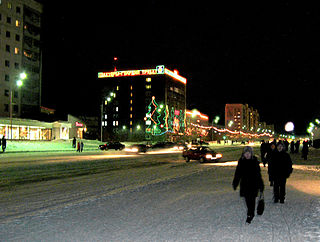
Vorkuta is a coal-mining town in the Komi Republic, Russia, situated just north of the Arctic Circle in the Pechora coal basin at the river Vorkuta. In 2010, its population was 70,548, down from 84,917 in 2002.

The Solovki special camp, was set up in 1923 on the Solovetsky Islands in the White Sea as a remote and inaccessible place of detention, primarily intended for socialist opponents of Soviet Russia's new Bolshevik regime.

Kolyma or Kolyma Krai is a historical region in the Russian Far East that includes the basin of Kolyma River and the northern shores of the Sea of Okhotsk, as well as the Kolyma Mountains. It is bounded to the north by the East Siberian Sea and the Arctic Ocean, and by the Sea of Okhotsk to the south. Kolyma Krai was never formally defined and over time it was split among various administrative units. As of 2023, it consists roughly of the Magadan Oblast, north-eastern areas of Yakutia, and the Bilibinsky District of Chukotka Autonomous Okrug.

Bakal is a town in Satkinsky District of Chelyabinsk Oblast, Russia, located on the western slopes of the Ural Mountains on the Chelyabinsk–Ufa railway branch, 264 kilometers (164 mi) west from Chelyabinsk, the administrative center of the oblast. Population: 20,940 (2010 Census); 22,314 (2002 Census); 24,101 (1989 Soviet census).

Kotlas is a town in Arkhangelsk Oblast, Russia, located at the confluence of the Northern Dvina and Vychegda Rivers. Population: 60,562 (2010 Census); 60,647 (2002 Census); 68,021 (1989 Soviet census).
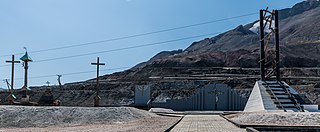
Norillag, Norilsk Corrective Labor Camp was a gulag labor camp set by Norilsk, Krasnoyarsk Krai, Russia and headquartered there. It existed from June 25, 1935 to August 22, 1956.
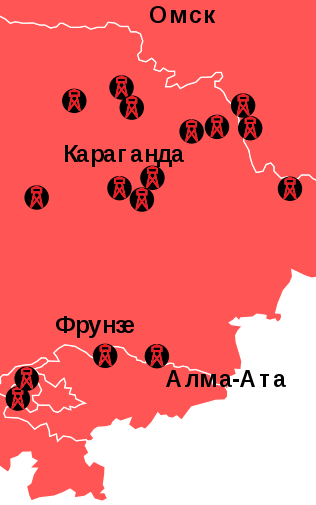
Karlag was one of the largest Gulag labor camps, located in Karaganda Oblast, Kazakh SSR, USSR. It operated during 1930—1959.
Baikal Amur Corrective Labor Camp (Bamlag) was a subdivision of GULAG which existed during 1932-1948.
Amur Railroad Corrective Labor Camp (Amurlag) was a subdivision of GULAG which existed during 1938-1941. It was created from the disbanded Bamlag. Its administration was headquartered in the settlement of Svobodny, Amur Oblast. Its main activity was railroad construction. Its peak headcount was about 125,000 (1938).

Komkor is the syllabic abbreviation for corps commander. It was a military rank in the Red Army and Red Army Air Force of the Union of Soviet Socialist Republics in the period from 1935 to 1940. It was also the designation for officers appointed to command a corps sized formation.
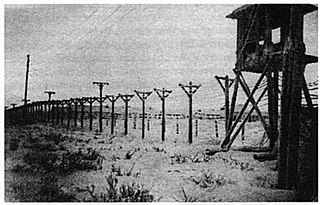
The Vorkuta Corrective Labor Camp, commonly known as Vorkutlag (Воркутлаг), was a major Gulag labor camp in the Soviet Union located in Vorkuta, Komi Autonomous Soviet Socialist Republic, Russian Soviet Federative Socialist Republic. It was in operation from 1932 until 1962.

Hava Vladimirovna Volovich, was a Ukrainian writer, actress, puppet theater director and Gulag survivor. In literary value and historical witness, her notes from the Soviet forced labour camps have been compared with Shalamov's stories and Anne Frank's Diary. Anne Applebaum wrote that Volovich stands out in the anthology "Gulag Voices", as she, like Elena Glinka, was not afraid to touch upon taboo subjects Volovich's story about her own child in the camp contrasts to some stereotypes about the selfishness and venality of gulag prisoners who bore children there.
The Akukan mine operated during 1927-1932 for the excavation of muscovite. It was located in the Akukan Ravine north of Baikal Lake, Buryatia, 40 km North-East-East off Nizhneangarsk, 7 km North of the village Kholodnaya.
Unzhlag or Unzhensky ITL was a camp of the GULAG system of labor camps in the Soviet Union. Named after the Unzha River, it has headquarters at the railway station Sukhobezvodnoye, Gorky Oblast. It operated from February 5, 1938 to 1960. The main operation was logging and wood processing industries, but also served a wide variety of other small-scale industries: construction, metalworking, railroad servicing, clothing, footwear, pottery production, etc. The camp had 30 sites (lagpunkts).
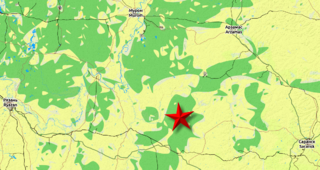
The Dubravny Camp, Special Camp No.3, commonly known as the Dubravlag, was a Gulag labor camp of the Soviet Union located in Yavas, Mordovia from 1948 to 2005.

The Inta Corrective Labor Camp or Intalag was a forced labor camp of the Gulag, which existed between 1941 and 1948 near the town of Inta in the Komi Autonomous Soviet Socialist Republic. Prisoners at the camp were mainly engaged in the mining of local coal deposits.
Usollag, full name: Usolye Corrective Labor Camp was a Gulag forced labor camp established on February 5, 1938 and functioned after the dissolution of Gulag, until 1960. It was headquartered in Solikamsk, now in Perm Krai, Russia, and it had numerous "lagpunkts" in the northern parts of the then Molotov Oblast. Its main occupation was logging and associated industries. Its reported peak occupancy was 37,000 inmates on January 1, 1942.
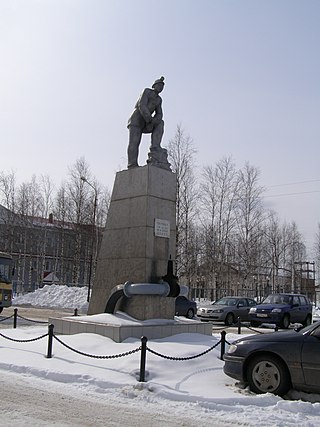
Ukhtpechlag or UPITLag was a Gulag labor camp in Komi ASSR. It existed during June 6, 1931 – May 10, 1938. Its headquarters were in Chibyu, now Ukhta. Its main work was oil and coal mining in Ukhta-Pechora Basin, as well as construction works and logging.
References
- ↑ Севжелдорлаг, at the Virtual Museum of GULAG